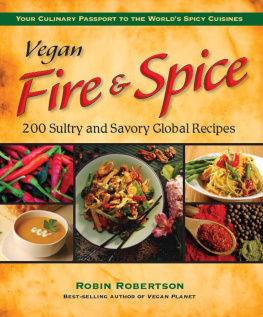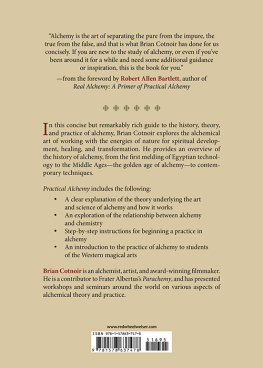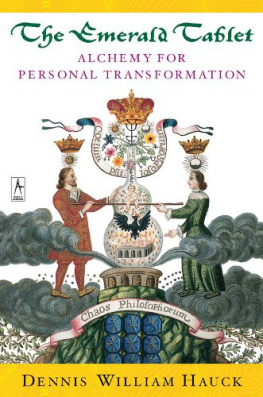
INDRAS NET
INDRAS NET
Alchemy and Chaos Theory
as
Models for Transformation
Robin Robertson

Theosophical Publishing House
Wheaton, Illinois * Chennai, India
Learn more about Robin Robertson and his work at www.questbooks.net
Copyright 2009 by Robin Robertson
First Quest Edition 2009
Quest Books
Theosophical Publishing House
PO Box 270
Wheaton, IL 601870270
Without limiting the rights under copyright reserved above, no part of this publication may be reproduced, stored in or introduced into a retrieval system, or transmitted, in any form, or by any means (electronic, mechanical, photocopying, recording, or otherwise), without the prior written permission of the publisher of this book.
The scanning, uploading, and distribution of this book via the Internet or via any other means without the permission of the publisher is illegal and punishable by law. Please purchase only authorized electronic editions, and do not participate in or encourage electronic piracy of copyrighted materials.
While the author has made every effort to provide accurate telephone numbers and Internet addresses at the time of publication, neither the publisher nor the author assumes any responsibility for errors or for changes that occur after publication. Further, the publisher does not have any control over and does not assume any responsibility for author or third-party websites or their content.
Cover image by Diamond Art
Cover design by Kirsten Hansen Pott
Library of Congress Cataloging-in-Publication Data
Robertson, Robin.
Indras net: alchemy and chaos theory as models for transformation / Robin Robertson.
p. cm.
Includes bibliographical references.
ISBN 978-0-8356-0862-6
1. Chaotic behavior in systems. I. Title.
Q172.5.C45R637 2998
003.857dc22 2008051949
ISBN for electronic edition, e-pub format: 978-0-8356-2140-3
5 4 3 2 1 * 09 10 11 12 13 14
To my editor, Jane Andrew, who, usually with my active agreement, though sometimes with my grumbling at the extra work, pushed me to make this a better book than it would otherwise have been. Shes been the toughest (and best) editor Ive ever worked with, and I hope we can work together again in the future.
Contents
Illustrations
Foreword
In early Taoism chaos, cosmos, becoming, time, and Tao are synonymous for that which is without an Orderer but is the sum of all orders.
N. J. Girardot
I n the timeless mythic past of both the Western world and the Far East, chaos, creativity, and transformation were understood as forming the interwoven fabric of a spontaneous cosmos. In line with this insight, Hesiod, writing in the Greek world around 700 BC, proclaimed that the primordial yawn of chaos was not about absolute disorder and confusion, or hollow emptiness, but a richly creative space from which flowed the dual cosmic forms of heaven and earth, space filled with the power of Eros or light.
Modern science has also discovered a close relationship between chaos and creativity. Many systems in nature, and in the human sphere as well, seem to evolve through increasing levels of complexity, each bounded and set apart from the others by regions of chaos. The universe itself comes down to us from a big bang after which matter as we know it today consolidated through a series of distinct phases, beginning with subatomic particles and continuing to atoms and the formation of the first generation of stars. These were the flaming cauldrons in which heavy metals were created to be scattered throughout space when these stars gave up their contents in cosmic-scale explosions. These very metals became the building blocks for the large organic molecules that eventually, in turn, became the building blocks for protoplasm and cellular life. In the meantime, huge clouds of dust and gases had consolidated into galaxies filled with solar systems and planetary bodies such as our own earth. At each stage of this cosmic drama, incredibly long periods of stability were punctuated by apparent disorder, chaos, and reorganization into more complex structures.
In its own way the evolution of organic life has followed a similar path. Progress was characterized by long epochs of little change punctuated by briefer periods of dramatic experimentation, creativity, and transformation. The first organic life on earth seems to have appeared around three and a half billion years ago, but not until two billion years ago or so did the first cells with complex internal structures appear on the scene. It was well over a billion years after that when the first multicellular organisms appeared, and most complex organisms as we know them today, from reptiles and insects to mammals, have all appeared during the most recent five hundred million years. This evolutionary pathway, characterized by long periods of stability and short spurts of creative experimentation and change, is so prominent in the historical record that it is referred to as punctuated equilibrium by paleontologists.
We find similar patterns in the development of our own inner lives. We have all lived through periods of stability, sometimes characterized by security and happiness and sometimes by ordinary boredom, followed by intervals of chaotic transition. We see this in childhood, in which distinct states of growth are apparent to everyone, each with its own pattern of emotion and behavior. Then comes adolescence, a dramatic interlude of biological and mental turmoil during which the young man or woman struggles to find footing while body and mind are stretched and torn both biologically and psychologically between the certainties of past childhood and the insecurity of future adulthood.
This rhythmic movement between chaos and stasis is the hallmark of psychological transformation. It is a cycle in which old structures eventually fail to find traction in a world of increasingly complex challenges, and a sense of confusion and chaos begins to emerge. Out of this chaos, however, appear the seeds of a new and more mature organization, one with more complexity and greater adequacy for dealing with the challenges of life. The overall shape of the process is reminiscent of the alchemical stages described in this book: an earlier substance is decomposed into a more primitive and chaotic form of great potential. Out of this potential emerges the substance of great value, nothing less than the philosophers stone, the priceless treasure extolled in alchemical lore.
Now a few words about the author. In ordinary life Robin Robertson wears many hats, not the least of which is that of a practicing magician. In the following pages he brings together his knowledge of chaos theory, his considerable experience as a Jungian psychologist, and his exceptional writing skills to create a work of remarkable literary alchemy. Perhaps no one else in the world could have synthesized so many insights from science, mathematics, history, and depth psychology, combining them with deep and abiding understanding of human nature and its many possibilities into a single lustrous thread.
Allan Combs
Santa Rosa, California
September 2008
Introduction
As the elements of the cosmos correspond to those within man, so both the process of creationand the process by which man, through the Art, reintegrates himself within himselffollow an identical path and have the same meaning.
Julius Evola
H ow is it that transformation comes about? In this book, were going to look at two models of that process, both of which ostensibly concern outer transformation, while on another level also speak about inner transformation. One is an ancient modelWestern alchemythat came into existence in the West during the first through the third centuries, reached its peak in the fifteenth and sixteenth centuries, and persisted in some form during the seventeenth and eighteenth centuries. In the nineteenth century, two writers, Mary Anne Atwood and E. A. Hitchcock, each wrote a book arguing that alchemy really dealt with the real purpose of religion: to restore mankind to the connection with divinity that existed before the Fall. In a private letter, Atwood contrasted that vision of alchemy with the mode of common religion: The common faith is mystery without a fulcrum in this life whereon to rest the lever of the will.
Next page

















